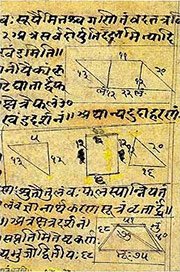Zero: 2 definitions
Introduction:
Zero means something in Hinduism, Sanskrit, the history of ancient India. If you want to know the exact meaning, history, etymology or English translation of this term then check out the descriptions on this page. Add your comment or reference to a book if you want to contribute to this summary article.
In Hinduism
Ganitashastra (Mathematics and Algebra)
Source: archive.org: Hindu MathematicsZero (in Mathematics) was invented in India about the beginning of the Christian era to help the writing of numbers in the decimal scale. The Hindu mind did not rest satisfied till it evolved the complete arithmetic of zero. The Hindus included zero among the numbers (śaṅkhyā), and it was used in their arithmetic at the time when the original of the Bakhshali Manuscript was written, about the third century A.D. The operation of addition and subtraction of zero are incidentally mentioned in the Pañcasiddhāntikā of Varāhamihira (505). The complete decimal arithmetic is found in the commentary of Bhāskara I (c. 525) on the Āryabhaṭīya. The results of operations by zero are found stated in the work of Brahmagupta (628) and in all later mathematical treatises.
The treatment of zero in the arithmetic (pāṭīgaṇita) of the Hindus is different from that found in their algebra (bījagaṇita).
Zero in Arithmetic:—The Hindus in their arithmetic define zero as the result of the operation: a - a = 0. This definition is found in Brahmagupta’s work (Brāhmasphuṭasiddhānta) and is repeated in all later works. It is directly used in the operation of subtraction. In carrying out arithmetical operations, the results of the operations of addition, subtraction and multiplication of zero and by zero are required. The Hindus did not recognise the operation of division by zero as valid in arithmetic; but the division of zero by a number was recognised as valid.
Zero in Algebra:—In the bījagaṇita, the same results are given with the addition that if a quantity is subtracted from zero, its sign is reversed, while in the case of addition the sign remains the same.

Ganitashastra (शिल्पशास्त्र, gaṇitaśāstra) refers to the ancient Indian science of mathematics, algebra, number theory, arithmetic, etc. Closely allied with astronomy, both were commonly taught and studied in universities, even since the 1st millennium BCE. Ganita-shastra also includes ritualistic math-books such as the Shulba-sutras.
India history and geography
Source: archive.org: Hindu Mathematics (History)Zero (in Sanskrit: Śūnya) is part of the ancient Indian place-value notation: the most important feature of the Hindu numeral notations.—In this system there are only ten symbols, those called aṅka (literally meaning “mark”) for the numbers one to nine, and the zero symbol, ordinarily called śūya (literally, “empty”). With the application of the principle of place-value these are quite sufficient for the writing of all numbers in as simple a way as possible. The scale is, of course, decimal. This system is now commonly used throughout the civilised world. Without the zero and the place-value, the Hindu numerals would have been no better than many others of the same kind, and would not have been adopted by all the civilised peoples of the world.
The zero symbol was used in metrics by Piṅgala (before 200 B.C.) in his Chandaḥsūtra. He gives the solution of the problem of finding the total number of arrangements of two things in n places, repetitions being allowed. The two things considered are the two kinds of syllables “long” and “short”, denoted by l and g respectively. To find the number of arrangements of long and short syllables in a metre containing n syllables, Piṅgala gives the rule in short aphorisms: “(Place) two when halved”; “when unity is subtracted then (place) zero”; “multiply by two when zero”; “square when halved”. [...]
The Bakhshali Manuscript (c. 200) contains the use of zero in calculation. For instance, on folio 56 [...]. There are a large number of passages of this kind in the work. It will be noticed that in such passages the sentences would be incomplete without the figures, so the figures must have been put there at the time of the original composition of the text, and cannot be suspected of being later interpolations.
The writings of Jinabhadra Gaṇi (529-589), a contemporary of Varāhamihira, offer conclusive evidence of the use of zero as a distinct numerical symbol. While mentioning large numbers containing several zeros, he often enumerates, obviously for the sake of abridgement, the number of zeros contained. For instance: 224,400,000,000 is mentioned as “twenty-two forty-four, eight zeros”; 3,200,400,000,000 as “thirty-two two zeroes four eight zeros”.

The history of India traces the identification of countries, villages, towns and other regions of India, as well as mythology, zoology, royal dynasties, rulers, tribes, local festivities and traditions and regional languages. Ancient India enjoyed religious freedom and encourages the path of Dharma, a concept common to Buddhism, Hinduism, and Jainism.
See also (Relevant definitions)
Starts with: Zerom.
Ends with: Nzero.
Full-text (+103): Khahara, Bindu, Vyoman, Candrayana, Nabhas, Viyat, Mahakharva, Shunyavadi, Mahaparimita, Mahakshiti, Mahakshoni, Khaguna, Khacheda, Mahanidhi, Mahaphani, Mahakshobha, Mahakratu, Kharva, Shunya, Sunne.
Relevant text
Search found 44 books and stories containing Zero; (plurals include: Zeros). You can also click to the full overview containing English textual excerpts. Below are direct links for the most relevant articles:
President of USA - An Appraisal < [July – September, 2000]
Demi-Gods < [April - June 1972]
The Blossoms < [October 1953]
Significance of the Moon in Ancient Civilizations (by Radhakrishnan. P)
2. Upanishad Shantimatra and Result of Karma < [Chapter 4 - Contemporary Astrological Viewpoint and Moon]
5. Chandramasa and Seasons < [Chapter 5 - Adoration of the Sun and Moon]
6. Mayan Civilization and Astrology < [Chapter 3 - History of Civilizations and Moon]
Jnaneshwari (Bhavartha Dipika) (by Ramchandra Keshav Bhagwat)
Verse 13.16 < [Chapter 13 - Kshetra and Kshetrajna Yoga]
Verse 13.13 < [Chapter 13 - Kshetra and Kshetrajna Yoga]
Verse 15.17 < [Chapter 15 - Purusottama-yoga]
A Heart Released (by Phra Ajaan Mun Bhuridatta Thera)
Teaching 15 - The Nine Abodes Of Living Beings
Teaching 14 - Activityless-ness Is The End Point Of The World
Vasudevavijaya of Vasudeva (Study) (by Sajitha. A)
Haricarita of Payyūr Ṛṣiputra Parameśvara I < [Chapter 1 - Śāstrakāvyas—A Brief Survey]
The Brahma Purana (by G. P. Bhatt)
Related products
(+14 more products available)





